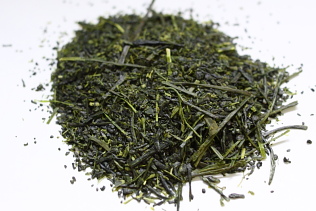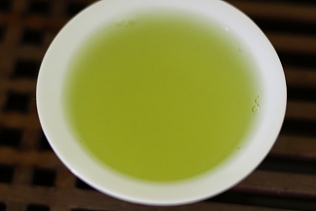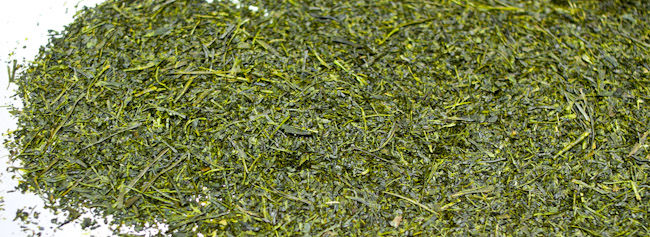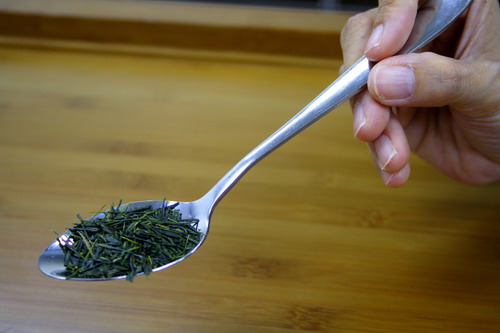
Thank you for visiting HOJO website. If you have any enquiry, please feel free to get in touch with us at
▼ Akira Hojo
▼ Hojo Newsletter
▼ HOJO FACEBOOK





HOME > Green Tea > Shizuoka Deep Steamed Sencha

Deep Steamed Sencha is called Fukamushi Sencha in Japanese. Although it has a very short history in Japan, it is getting very popular nowadays. “Fuka” in Japanese means “deep” and “Mushi” means “Steaming”. In English, it is called Deep Steamed Sencha. Literally to its name, it is called Deep Steamed because of during the process of this tea, it is steamed much longer compared to standard Japanese Green Tea such as Sencha or Gyokuro. Originally, Deep Steamed Sencha was developed in order to savor low quality crops that was grown at lower altitude tea gardens or plucked later in the season. These tea leaves always give a bitter and astringent taste. The longer steaming process causes more destruction to the tea leaf and oxidation of poly phenol will take place. As a result, longer steaming process makes tea taste less bitter and less astringent, yet with much thicker taste.
Compared to ordinary Sencha, Deep Steamed Sencha has a deeper vibrant green color, and it gives a thicker taste with fuller body. However, Hojo particularly selects the Deep Steamed Sencha from Nissaka that is located on the slope of mountain situated in Kikugawa. We deliberately select the material that is plucked earliest in the spring. The tea leaf is tender and soft, and moreover that particular tea garden is situated on the slope of mountain. Unlike ordinary commercial grade deep steamed sencha, the tea leaf we selected for our Deep Steamed Sencha is originally not bitter and not astringent at all. Such same quality tea leaf is also used in making Asamushi Sencha. Since our material is of superior quality, we did not have to conduct steaming process for too long, although the steaming time is still longer than normal sencha.
 |
 |
|
| Tea leaf of Nissaka Deep Steamded Sencha | Nissaka Deep Steamded Sencha gives very green liquor . It is easy to drink and thick in body. |
Nissaka Deep Steamed Sencha is produced from Yabukita cultivar. Starting from the end of April until the beginning of May, the first flush is plucked based on the criteria of one bud and two leaves. Hojo selects the first flush, in particularly the earliest batch. The reason is that soon after this period, the raining season begins and tea plants grow very fast and this will cause the taste of tea becomes thinner.
Plucking is conducted after sunrise in order to avoid morning dew. Contamination of the morning dew will cause partial over-heating during the steaming process. This will destroy the tissues of the tea leaves and affect the quality. Therefore, good tea must be produced from tea leaves plucked on a sunny day.

Tea leaves plucked from different tea gardens are segregated. Different tea gardens carry different lot numbers and will not be mixed in order to establish a clear traceability.
The character of Deep Steamed Sencha is influenced by the steaming process. Conventional deep steamed sencha is steamed for more than 1 minute. As a result, tea leaves become very fragile and simultaneously the substances in tea leaves will be excessively oxidized. Eventually, deep steamed tea will gives a sweet and mild taste.
Right after the steaming process, tea leaves has to be cooled down immediately and at the same time excessive moisture from the tea leaves has to be vaporized. The immediate reduction of wet heat is very crucial in order to avoid secondary heating of tea leaves.
Tea leaves are agitated under the hot air for efficient drying purpose. At the same time, the mixing will soften the leaves.
This is the only process conducted without heat. The machine moves in circular motion with pressure that spread the moisture of the tea leaves evenly. The tea leaves generate heat due to the friction. Therefore, at regular intervals it is necessary to loosen the tea leaves and release the heat.
A drum dryer is used to gently roll the tea leaves and promote drying, reducing moisture, and twisting the tea leaves into a finer shape.
It is a reciprocal movement of the back and forth motion, combined with circular movement twisting the tea leaves into a needle shape. High quality Sencha appears to be dark green in color, shinny and solid.
After the final rolling, tea leaves still contain moisture. Further drying will reduce the moisture down to 5%. These leaves are called Aracha (crude tea). Aracha does not undergo the firing process. Compared to the finished product, Aracha has a much stronger flavor of fresh leaves and bitterness.
Each tea wholesaler will purchase Aracha as raw material, and based on their individual process, they will conduct firing. This is how they create their original quality. Subsequently, they will blend a few kinds of tea in order to create a wholesaler's original brand.
In you are using tap water, it is necessary to filter the water using an activated carbon filter. If not, you wouldn’t be able to enjoy the authentic taste of tea. Chlorine is added to tap water in order to sanitize bacteria. This chlorinated water will also harm our body cells. Concerning about our health condition, it is very important to remove chlorine from drinking water. The most effective method in removing chlorine is to install an activated carbon filter. This type of filter is designed for removing organic substance. It will remove not only chlorine, but also other harmful substance such as contaminated pesticide. The activated carbon filter can be easily obtained from the common hardware shop in most countries. If activated carbon filter is not available, please place a charcoal inside the water and leave it for over night. The material composed of activated carbon filter is made of ground charcoal. The difference is that activated carbon filter contains much finer particles and hence it has extremely large surface area for a better efficiency in filtration. We do not suggest RO water (reversed osmosis water) or distilled water. This water carries no mineral, the taste and flavor of tea tends to be very unstable, unless you have very superior quality tea and tea equipment.
It is also advisable not to use fresh tap water. The intensity of after taste becomes stronger if water is kept overnight. Keeping water with stones or inside clay jar will increase the content of minerals. However, you need to confirm whether or not the water kept inside particular jar or with stone is suitable with your tea or tea equipment (such as teapot). If water jar carries certain minerals like copper or zinc, it will rather spoil the taste and flavor of tea. For this, you need to confirm with experiment on try and error basis.
For boiling water, please do not use aluminum or copper kettle. It spoils the taste of water. We suggest using kettle made of iron, stainless steel, tin or glass.
In the long run, you may observe a thick layer of scale accumulated inside your kettle. Our mother usually taught us to wash and remove it with citric acid. But please do not even try to remove the scale. Scale consists of minerals that exist in the water. The percentage of minerals is according to water you used. If you remove the scale, the mineral ion balance between scale and water is destroyed. This balance is called buffer effect in science. The flavor and taste will seriously run out and you won’t be able to get previous taste and flavor for a long time. It is also important to stick to the same type of water whenever brewing tea. If source of water is changed, it carries different type of minerals. It will affect the mineral ion balance too.
Go to further information about suitable water for brewing tea >>

Please use 1g of tea leaf for 50ml of water. For example, it is 4g if you use 200ml of water.
To determine the quantity of tea leaves to be used, we divide the volume of water by 5. For example: the volume of teapot = 200ml; 200ml/50 =4g. You need to measure 4g of tea leaves for 200ml of water.
It is important not to use boiling water. Boiling water should be poured into an empty glass or any container, let it cool down until you can hold the glass by hand for 5 seconds. Usually the temperature is relatively higher for Deep Steamed Sencha at around 80-85 degree Celsius. For second brewing onwards, brewing time must be less than a few seconds. It is as short as just run through hot water.
Pour the hot water into the tea pot, and brew for 1 minute. For the second brewing onwards, brewing time must be less than a few seconds.
Traditionally, the Japanese never use a pitcher. The tea is directly poured from the tea pot into respective tea cups. In order to make the concentration evenly, we have to pour one cup after another, repeating a few times until the last drop of tea. However it is absolutely more convenient and advisable to use a simple pitcher. The purpose of pouring until the last drop is to extract the concentrated liquor. This is important as tea leaves must be filtered well and kept without water to avoid the liquor becoming bitter and stewed. Besides, it prevents tea leaves from being over cooked. In addition, filtration will make it ready for the second brewing.
After pouring the tea, you have to leave the lid open to avoid further steaming of tea leaves.
Once a bag of tea is opened, please finish it within 3 months if you wish to enjoy its freshness. From the medical point of view, it is safe to consume the tea even if it is kept for a few years. However the freshness disappears if it is kept for too long. Tea must be tightly sealed before it is kept. Tea should be kept in ambient and dry conditions such as in the living room, but it must be completely away from humidity. Tea should not be kept in the kitchen as the environment is very humid. Avoid enclosed area such as inside the cupboard or drawer as these places are damp. Also avoid opening the bag of tea in humid atmosphere. It is recommended to open the bag during a sunny day or under air-conditioned atmosphere. Once tea leaves absorb moisture, deterioration of tea will be triggered within a few days. Tea will then give an astringent taste, sometime might even taste sour. The fresh aroma also becomes weaker.
The quality of tea lasts longer if it is kept in the fridge. However we strongly recommend you not to keep tea in the fridge. When tea is withdrawn from the fridge, usually water condensation will take place. Once tea is exposed to moisture because of water condensation, the quality will deteriorate within a few days. The higher moisture content in the tea leaves triggers oxidation and it will completely spoil the quality of tea.
Here’s one frequently asked question: what if I seal the bag using tape or what if I pack the tea in a zipper bag and store in the fridge?
For your information, these simple sealing methods are not sufficient. When the bag is withdrawn from the fridge, it is cold inside the bag and therefore causes negative pressure. Air will be drawn from outside and water condensation will take place. In addition, if the bag is frequently taken in and out from the fridge, this will cause heat stress to the tea leaves as temperature is increased and decreased very frequently. If tea is kept in the fridge, when it is withdrawn from the fridge, it is necessary to leave it in ambient atmosphere for more than 24 hours in order to warm up the tea leaves. Based on our experience, 12 hours is not long enough. We may think tea is warmed up, but inside the bag, the tea leaves are still cold due to insulation.

Please feel free to send us e-mail for enquiry at:

 |
We accept various kinds of credit card through Paypal.
Only if customer prefer other option of payment, we suggest "Bank Transfer".
Various choice of shipping method
EMS, SAL, Small Packet, Small Packet (SAL) Yamato Express and Surface
For shipping tea, we usually suggest small air parcel, the estimated shipping cost of tea in 100g (with wrapping material ) is
Small Parcel
USA JPY 600, EU JPY600 and Asia JPY470
Small Packet (SAL)
USA JPY380, EU JPY380 and Asia JPY320
The shipping fee to oversea by small air parcel happens to be even cheaper than domestic shipping fee in Japan.
For your information, some countries, EU in particular imposes custom duty. We need buyer to bare the duty. We are sorry, but we cannot change the amount on the invoice, and we do not mark any packages as gifts. We will strictly follow the custom regulation.